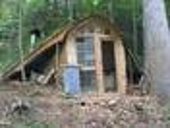I wrote up this little article summarizing the earthship concept over at my blog
http://www.mypermaculture.net/?p=107 . Check it out and let me know what you think.
I'll post it here for you guys as well.
Let’s have a look at the earthship building design concept and see what it’s all about.
I’ll start off by listing the basic design principles behind the earthship and then go into more detail later.
1. Thermal/Solar Heating and Cooling
2. Solar and Wind Electricity
3. Contained Sewage Treatment
4. Building with Natural and Recycled Materials
5. Water Harvesting
6. Food Production
Just by looking at the main design principles, you can see the idea behind the earthship design is to take our most basic needs and bring them into one building, where the occupants have direct access and control over them. By decentralizing the control over our most basic needs, the earthship design seeks to help the occupants attain a certain level of freedom, as well as reduce the environmental impact of these centralized system.
So let’s have a look at each of these design principles and go into a little more depth about what they mean.
Thermal/Solar Heating and Cooling
I would say this is the fundamental design principle behind the earthship concept. The idea that the building can pretty much (depends on climate, location, and design) heat and cool itself using only the sun and thermal mass is pretty awesome. But how does this work and what is thermal mass you ask?
Well let’s start with thermal mass. Thermal mass can be any dense, heavy stuff like water, rocks, or compacted earth. Dense means no voids or air spaces. The more dense the mass the more temperature it holds. This density acts as a conduit for temperature. Think of the lake where you like to go swimming. If it is early summer and one of the first hot days, the lake is still going to be cold from the winter even though the air temperature is hot. This is because the lake is a very large mass that has stored all the cold energy from the winter and it will take a long time to lose that cold energy and start to gain heat energy from the warm days of summer. This also works the other way, when it has been hot for a long time and then there is a cold day, the lake will still be relatively warm, having stored all that heat energy from the hot days.
The thermal mass in an earthship works on these principles. The outer few feet of the earth’s surface heat up and cool off depending on the weather. But deeper in the earth, about four feet and beyond, the temperature is more constant, being sheltered from the weather above. Here, the earth can be used to both cool and stabilize temperatures.
In the winter when you want to heat the home, you let the low winter sun shine in on the thermal mass walls of the earthship. The sun heats the mass, the mass stores the heat. The more mass, the more storage capacity. When there is no sun, the heat stored in the mass radiates into the living space.
In the summer when you want to cool your home, you open an air duct running underground and a vent in the greenhouse, which brings in the cool, stable temperature (around 55F) of the earth and lets the hot air escape. This coolness is then stored in the mass of the earthship, further helping to regulate the temperature in the living space.
In summery, the mass of the building helps to stabilize the temperature and with a little input from the sun’s warmth, or the earth’ s coolness, the temperature in the living space is kept relatively comfortable. In some cold climates, where the sun doesn’t shine much in the winter, there could be a need for supplementary heat, but this would be used very minimally.
Solar and Wind Electricity
Earthships produce electricity using solar panels and wind mills. This electricity is then stored in batteries to be used when needed. The more electricity one needs, the more panels/wind mills and batteries are required. These are usually the most expensive element when building an earthship, so if you want to keep the cost down, the first thing to do is reduce your energy consumption. Basically you can run any regular home appliances on these systems, it’s just a matter of how much you want to spend on the set up.
Earthships can also be hooked up to the regular power grid, if the occupants decide this is the route they wish to go. This could be a cheaper way to provide all your electricity needs, if you have a lot of appliances to run and the grid is nearby.
Contained Sewage Treatment
The earthship strategy for treating sewage is based on the observation of wetlands, which have been naturally cleaning water for millions of years. The idea is that the dirty water flows slowly past the roots of plants, which take up the nutrients and turn it into greenery. There are also billions of bacteria which interact with the dirty water and plant roots, also helping to break down any pathogens.
The earthship is set up to use water four times before it leaves the system. The first time is when taking a shower, doing laundry, washing dishes, or brushing your teeth. The water that then flows down the drain from these activities is called grey water. It is somewhat dirty, but not that dirty.
This grey water is then routed through indoor, rubber lined botanical cells, which are planted with a variety of different plants. These plants feast on the nutrient rich grey water and clean it in the process. The second use of the water being to grow indoor plants in the greenhouse, which can be both ornamental and edible. Because of the warm conditions of the earthship, plants will be able to grow year round in these planter cells, providing food and a lovely atmosphere.
The third use of the water comes when flushing the toilet. The grey water that has been used by plants and filtered, is then pumped to the toilet tank and used to flush. There is no need for the toilet to use perfectly clean water to flush, so the grey water, which has been used for two different purposes already, is perfect.
For the fourth and final use of the water, the extra dirty black water, from the toilet, is sent out into a septic tank. From the septic it is directed into outdoor, rubber lined botanical cells, planted with wetland plants specifically chosen to treat sewage. These plants help to break down pathogens from the dirty black water and grow to look nice at the same time. There can be a series of these outdoor treatment cells, depending on the sewage load from the house.
Once the black water has passed through all the planted treatment cells, it is then released back into the ground. This water is now much, much cleaner than if it were just let out into a conventional leach field from a septic and it has been used to grow all sorts of non edible plants.
Building with Natural and Recycled Materials
This aspect of the earthship build is probably the second best place to save money, after the electricity part. If you put in a bunch of time and effort, you can come up with all sorts of recycled material to use, instead of buying it new. Like windows, doors, tubs, toilets, insulation, floor tiles, etc. The main recycled materials used in most earthships though, are recycled bottles, cans, and tires.
The bottles and cans are used as filler when building interior walls with cement, so not as much cement is needed, and when packing out the spaces between the tires to create a smooth interior wall. The bottles can also be used to make beautiful stained glass art.
The tires are used as the main structural element, when filled with rammed earth to create the monolithic, thermal mass walls. These walls are incredibly massive and stable. Here is a good shot of one.
As far as natural materials goes, the dirt in the tires, logs for the roof, and mud plaster to pack out the spaces between tires is about it.
Water Harvesting
The earthship concept is designed to catch rain water that falls on the roof and store it in underground cisterns, where it is then pumped into the house, filtered, and used by the occupants. The size of the cistern depends on the annual rainfall in the area where the earthship is to be built. If there are very long stretches of no rain, then the cistern will be considerably larger than places where it rains all the time.
Catching rain water is especially good where the ground water has been polluted, or mostly used up to the point where a well would need to be super deep to access it. It is also good for not contributing to the depletion of aquifers.
Food Production
Earthships create an environment where plants love to grow, not only for aesthetics, but also for food production. The large south facing windows and grey water planter cells make it perfect for growing plants. The plants don’t need to be watered because of the grey water running through the planters, and they have excellent light exposure.
By growing plants in this greenhouse space along the front of the earthship, you are able to have year round access to fresh food. This growing space is kept warm using the thermal/solar heating principle from above, allowing for some exotic plant species to be kept, that would otherwise die out doors. A popular example is banana plants.
Having year round access to fresh, nutrient dense, organic food gives a major boost to over all health and well being. There is nothing like having fresh tomatoes, picked from your planter, in January when the snow is flying outside. This also adds a real sense of security, knowing you can grow food inside your own home year round.
Here are some great shots of the earthships full of wonderful plants.
All in all the earthship building concept is an excellent example of a better way to design homes, by harmonizing with the natural elements and using them to bring control over the essentials for life back to the occupants.
There is something to be said about living in home that heats and cools itself, produces electricity, treats sewage, catches water, and grows food.

 2
2








 1
1




















 ...as usually you are great to quibble with...
...as usually you are great to quibble with...

















































